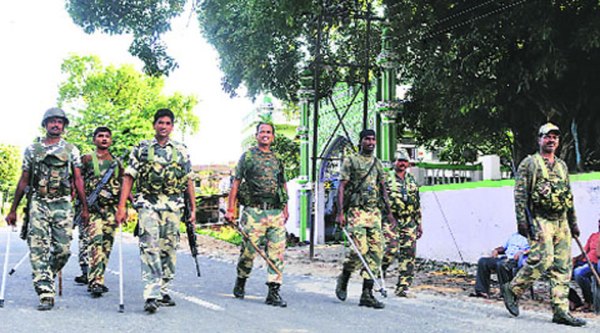Bihar has seen over 170 incidents of communal clashes since June 2013, when the BJP parted ways with the JD(U) government. That’s more than 10 incidents a month, nearly thrice the average of three-four when the parties were together.
Last month, the Bhojpur district administration succeeded in preventing one such incident following violence over immersion of an idol at Sahar in Ara. Over a dozen people were injured, including three policemen, and five roadside shops burnt before the situation was brought under control.

On Tuesday, a Special Auxiliary Police constable was injured during stone-pelting between Hindu and Muslim groups over partial damange to a Hindu deity statue in Aurangabad.
Story continues below this ad
According to sources, while some situations have been handled with community intervention, FIRs have been registered in over 70 cases of minor clashes. Over 25 people were arrested and later released on bail. Only in the worst case of communal riot, Nawada in August 2013, in which a Hindu and a Muslim were killed, were three people booked, including a Bajrang Dal worker.
Over three dozen people have have been injured in the clashes, which began soon after the JD(U)-BJP 17-year alliance broke up.
Since Jeetan Ram Manjhi replaced Nitish Kumar as Chief Minister in May, there have been 38 cases of communal clashes.
During Nitish’s seven-and-a-half years of the NDA government, the state had seen no major communal clash.
Ten communal incidents were reported in September, the highest in a month so far since June 2013. This month has seen three major communal clashes, at Kishanganj, Saran and Bhopjpur. Prohibitory orders had to be imposed in Kishanganj for two days after the head of a cow was reportedly found near a temple, while Saran saw trouble over idol immersion.
Most clashes, including last month’s, happened after an attempt to divert idol immersion routes to Muslim pockets.
Bihar Minority Welfare Minister Shahid Ali Khan played down the clashes as “over-reading of minor incidents between neighbours from different religions”, but added that the state government had been watchful.
Story continues below this ad
Bhojpur SP Rajesh Kumar admitted there had been tension. “There was some provocation because of stone-pelting from the other side, but we were able to defuse the tension and will keep police forces posted here for some time. We will engage the community at some stage.”
The Bihar Police headquarters does not keep a separate record of “communal violence” but lists such cases under “riots”, a category that covers sundry clashes irrespective of the caste and religion of offenders. The figures by The Indian Express are of communal violence.
The rise in the number of violent incidents suggests that the JD U) government, which is now running without a “cadre-based” BJP, is not able to nip such incidents in the bud, unlike earlier, when leaders of the BJP would be asked to “engage community leaders at the grassroots level”.
The clashes also reflect a growing distrust between the Hindus and Muslims now that they owe loyalty to different political parties. “Under Nitish, both the Muslims and Hindus had a stake in the NDA government and Hindu organisations did not dare embarrass the government. Now, even if organisations like the RSS, VHP and Bajrang Dal are not directly involved, their aloofness from engaging communities at the grassroots level has made the task difficult for Manjhi,” said a former DGP.
Story continues below this ad
Worsening matters, some extremist Muslim organisations have become active in areas like Kishanganj, Araria and other Muslim strongholds. Said a senior police officer: “We learnt that one such group played a role in getting JD(U) Kishanganj Lok Sabha nominee Akhtarul Iman to withdraw from the race to ensure Congress candidate Asrarul Haque’s win against the BJP nominee (Iman had dropped out at the last minute, leaving the JD-U without a candidate in the seat). The recent communal clash in Kishanganj may be because of provocation from such an organisation.”
Between June and December 2013, there were 87 major and minor communal clashes, with the only relatively peaceful month being October 2013 (four cases). In contrast, the state saw only 24 such incidents in the corresponding period in 2012. Between January 2014 and September, 83 incidents of communal clashes had been reported.
Most of the incidents have been reported from Khagaria, Betiah and Nawada, apart from Jamui, Kaimur, Gaya, Saran, Bhojpur and Sitamarhi.
Shahid Khan said he didn’t want to engage in any “blame game”. “There has been talk in the media about latent communal polarisation before the last Lok Sabha elections. But I would call it over-reporting of minor clashes that must have been occurring earlier too between neighbours from two religions.”
Story continues below this ad
Asked if the government sees any provocation from any organisation, the minister said: “We have no knowledge of such a trend. The police have been doing their duty and the political leaders are doing their job… Let us take it as a common law and order issue.”

 Security forces in Nawada after the violence. (Source: Express photo)
Security forces in Nawada after the violence. (Source: Express photo)






